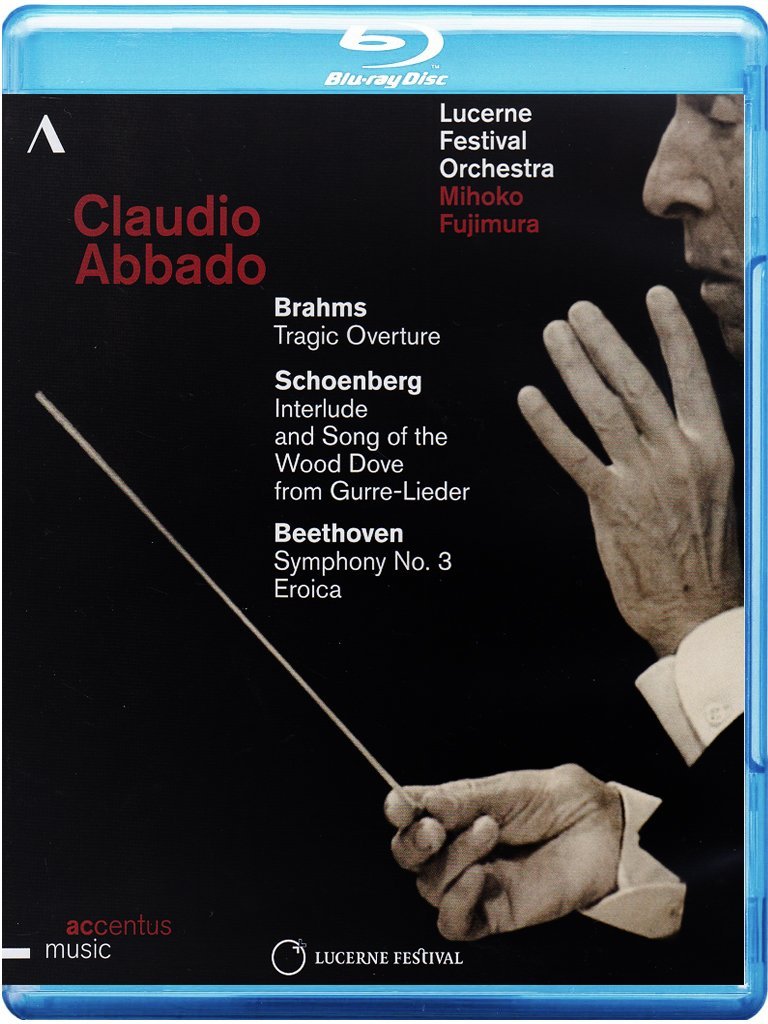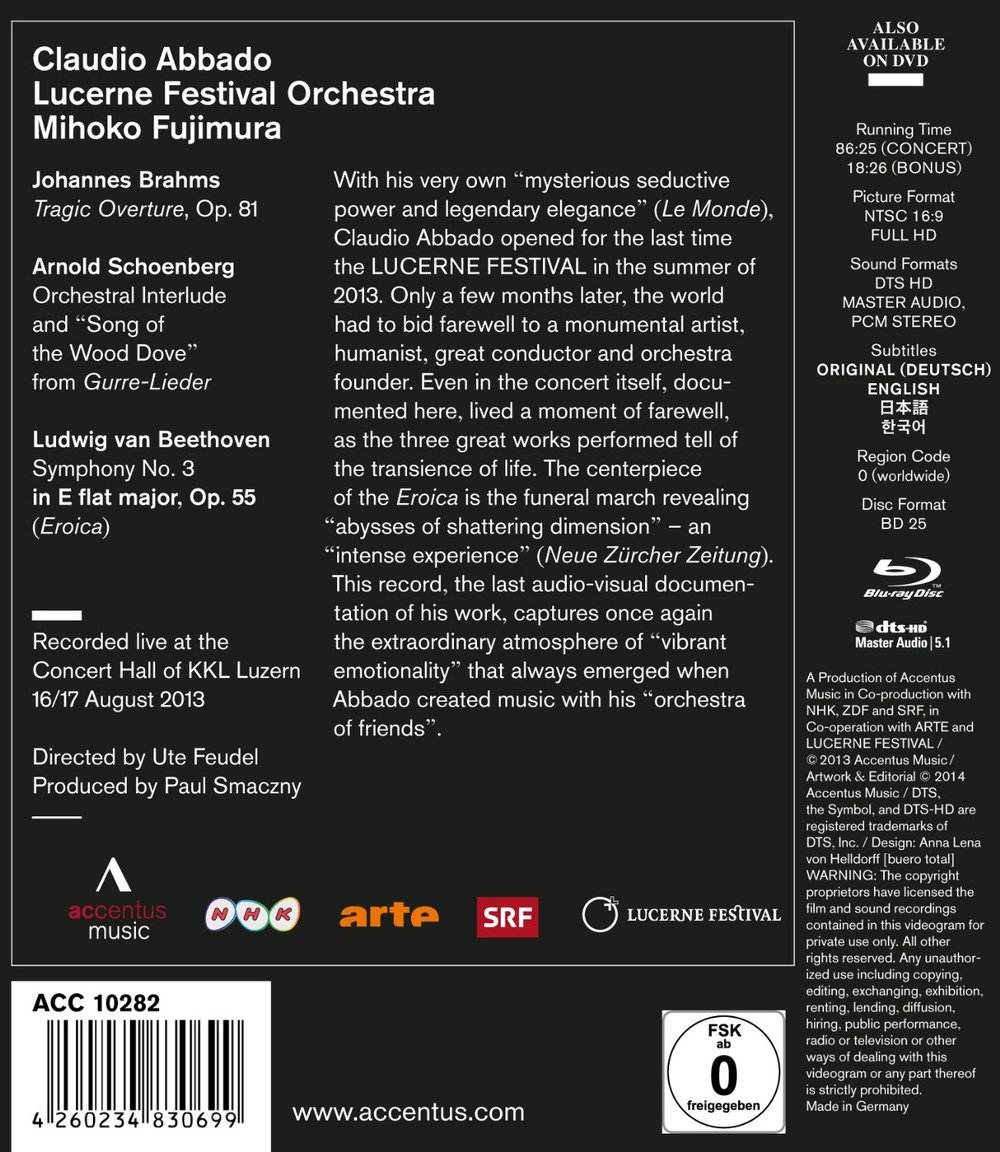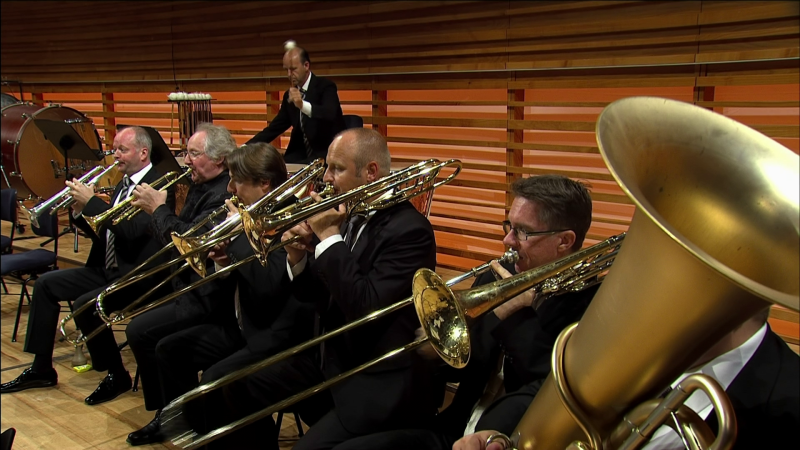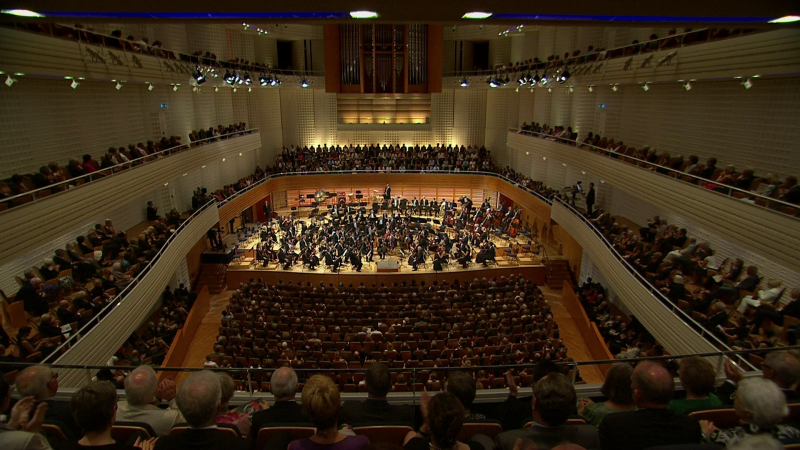

The Beethoven Symphony No. 3 concert includes:
Brahms Tragic Overture
Schoenberg Interlude and Song of the Wood Dove from Gurre-Lieder (with alto Mihoko Fujimura)
Beethoven Symphony No. 3, the "Sinfonia Eroica" or "Heroic Symphony"
Claudio Abbado conducts the Lucerne Festival Orchestra in opening the summer festival in 2013. Directed for TV by Uti Feudel; produced by Paul Smaczny. Released 2014, disc has 5.1 dts-HD Master Audio sound. Grade: B-
At first glance, this might appear to be an overly somber and rather short program. But Abbado had been sick for a long time, and he died about four months later. Everyone understood that Abbado selected the music in this program to be his swan song.
As you can see from the first four screenshots below, the picture quality of the video is excellent with fine resolution, pleasant and rich color balance, and no motion artifacts.
There were few empty seats:
Abbado valiantly smiled and greeted everyone as warmly as his devastated frame allowed. But he basically appeared as a living death-mask, and some of the images reveal the pain he suffered doing this:
The audience was loaded with celebrities such as Pierre Boulez seen below. The video captures the emotions of the event. But our task now is to determine how well this recording honors the deceased:
The program opens with the Brahms Tragic Overture. The performance by the famous Lucerne Festival Orchestra under their beloved leader is, of course, exemplary. The sound quality, recorded at 48kHz/24-bit, is typical for the symphony Blu-rays we are getting these days with a pleasant blending of the instruments and sections, decent dynamic range, and good renditions of the pizzicato passages, etc. The Tragic Overture sounded familiar. I reached for my Blu-ray of the Brahms Symphony No. 2 played by the Saito Kinen orchestra under Seiji Osawa, which was recorded with 96kHz/24-bit sound sampling. Sure enough, the First Movement of Symphony No. 2 is quite similar the the Tragic Overture. But the sound recording of the Symphony No. 2 by NHK (96kHz) is distinctly superior to the recording of the Tragic Overture. In the recording of the symphony (96kHz) I don't hear blending — hear separate instruments and sections playing in various ensembles as the score progresses. It's a much closer approximation to "being there" than I get listening to the Lucerne Festival orchestra (48kHz). At the moment, I can't think of any better demonstration of the advantages afforded by using 96kHz/24-bit sound sampling in recording a symphony. The superior Saito Kinen recording was made in 2009. You would think that the rest of the recording industry could catch up with NHK in the 4 years between 2009 and 2013, but this had not happened.
Up to this point we have noted an excellent performance with good picture quality and decent but less than state-of-the-art sound. Now we come to the real problem with subject video---its obsolete video content infected with DVDitis. DVDitis is a disease that mostly afflicts recordings of symphony concerts that were intended to be published as DVDs and which are also published in Blu-ray. Because of low video resolution, DVD recordings can't provide good shots of an entire symphony orchestra or long shots of multiple sections of the orchestra. To cope with this limitation, the practice developed of shooting many short clips of the conductor alternating with many short clips of single musicians or small groups of musicians. This style of recording reminds me of the Road Runner cartoons.
But when you shoot a symphony orchestra with HD cameras, you can get decent long-range shots of the whole orchestra and its larger sections. So a symphony HDVD can be displayed in a more civilized and relaxed way that gets much closer than a DVD to the live experience a concertgoer has in the music hall. Find out more about this in our special article about the good symphony video in HDVD.
When a DVD is made of a symphony concert, you do the best you can with the modest resolution you have. If you take that recording and publish it on a Blu-ray disc, the consumer should get a nicer video picture and often also better sound. But it's still the Road Runner race. A good HDVD of a symphony has to have different and better video content from the DVD to meet our standards. If the HDVD has the same video content as the DVD, I diagnose DVDitis.
A main symptom of every case of DVDitis is a fast pace of video clips. Our Tragic Overture runs 14 minutes and 13 seconds, during which I count 170 clips. This produces the lung-bursting, brain-straining pace of 5 seconds per clip. (A good HDVD of a symphony will normally have a pace of 10 to 15 seconds or more per clip.) Numerous clips of the conductor is another chief symptom of DVDistis. Here we have 52 clips of Abbado, and many of them run longer than the average 5 seconds per clip. This means that well over 31% of the total run time in the Tragic Overture shows Abbado directing instead of the orchestra playing. There are also 85 clips of single players and small groups (over 50% of the total video), another typical sign of DVDitis.
However, two factors may somewhat reduce the severity of this case of DVDitis. First, some viewers might have a special interest in seeing Abbabo conducting his own memorial. Second, this recording does have 10 whole-orchestra shots such as the one shown in the next screenshot. Whole-orchestra shots are characteristic of a good HDVD. The only problem with the whole-orchestra shots in this Tragic Overturevideo is that they last only 5 or 6 seconds each---so the viewer still doesn't get time to thoroughly enjoy them:
A good symphony HDVD will have many shots of whole large sections including the 5 string sections. This Tragic Overture does not have a single view of an entire string section. The closest we get to this would be the angle below of 5 of the 6 double-bass players. Why not get all 6 players in the frame?
A good symphony HDVD will also have many shots of multiple sections at work. Our Tragic Overture has by my count only three of these. The next screenshot is the best of these with three brass sections performing as a choir:

For lack of 96kHz/24-bit sound sampling and a raw case of DVDitis, we would normally mark this Tragic Overture down to a "C+" at best. But because of the fair number of whole orchestra shots and the special interest in Abbado, I'll move the grade for this segment of the disc up to a "B."
Next we turn to our Schoenberg piece, the Interlude and Song of the Wood Dove. This is but a small part of a huge cantata called the Gurre-Lieder. It's late romantic in style, and it is perhaps Schoenberg's most important work before he adopted atonality and became part of the Second Viennese School.
Gurre-Lieder is scored for a huge orchestra and chorus. For this Song of the Wood Dove we find augmented sections everywhere with, for example, four harps, four trombones, five bassoons, ten double-basses, and 16 violas onstage. The screenshot below shows how the orchestra fills the stage. This was doubtless impressive to the audience. But this sudden expansion of the orchestra on stage creates a big problem in the home theater: sound quality falls off a cliff. My guess is the same mikes and wires were used to record the Song of the Wood Dove as were used for the Brahms and Beethoven. It didn't work. Now the orchestra sounds muddy (I'm reminded of those nature movies of elephants wallowing at the river bank). The music doesn't match well to the video. For example, I frequently see the four harps playing in unison, but I can just barely hear them. Schoenberg must have intended for this squad of harps to create stunning sounds, but it's all lost in the mish-mash. So I'll have to mark down the sound quality for this segment drastically.
With such large forces on stage, a case of DVDitis is probably inevitable. Even HD cameras can't get great whole-orchestra shots when the stage is absolutely full (we need 4K or 8K for that). Still, the TV director tried with 9 whole-orchestra shots, all too short. His best long-range view turned out to be this attractive part-orchestra angle where you get a rare chance to see all the violins and all the cellos as well as other sections:
And the next three shots all have brilliant views of multiple sections at work. Here's an impressive view of harps and horns:
And the brass choir again with a tenor trombone, two bass trombones, and a contrabass trombone (hope I got that right):
Here's a beautiful shot of woodwinds:
Well, that's all the good stuff of the Gurre-Lieder orchestra. Now back to DVDitis. This music lasts for 19 minutes and 14 seconds and has 189 clips. So even with a solo singer featured in the mix, the pace is a too-fast-for-comfort 6.1 seconds per clip. 42% of the clips are of single players or small groups shown in isolation swimming in this vast school of musicians. And even though the solo singer should get most of the attention, 26% of the shots are still lazy views of the conductor:
Alto Mihoko Fujimura should be the undisputed star of this piece. But she gets about the same amount of attention as the conductor with 43 clips (22% of the total). Still, she manages to come from behind and tell the song-of-the-dove story quite well. And she was properly miked so one can hear her over the hordes behind her. Even without the subtitles, you might guess what she's singing about violence . . .:
So I sum up the Schoenberg piece as an spectacular sight with poor sound recording and a classic case of DVDitis somewhat mitigated by an impressive sung role. I'll give this segment a "C."
Now that we have 2 warm-ups behind us, we can turn to the Beethoven Symphony No. 3 with its famous funeral march. The sound recording is back to the same level we noted with the Brahms Tragic Overture. But we also encounter an absolute orgy of DVDitis. The performance of 55 minutes, 20 seconds is cut up into an insane 689 clips averaging a speed-of-light 4.8 seconds per clip, and this with the slow funeral march movement! There are 220 conductor shots (32% of 689 total clips). There are 349 clips (50% of 689) of single players, small groups, and instrument-only views. On the other hand, there are 33 whole-orchestra and part orchestra shots, but at 5 or 6 seconds each, they are too brief to properly enjoy:
There's next to no effort to show the violins and violas as a section. Out of 689 views, there should be at least a few decent multi-section shots, and here is one of them:
There are also some attempts at shots of smaller sections, but they are poorly executed. The cello section has ten players, but you will never see more than nine as below:
And there are quite a few shots of five double-basses:
But only one shot that shows all six of the dbs. And this is the only view in the entire symphony that shows all the players in a string section:
Amazon customer reviews suggest that the performance was extraordinary. In its September 2014 edition, the French music magazine Diapason gave this recording its “Diapason d’Or Arte" award of excellence. Well, I wonder. We have another HDVD of Beethoven 3. So I compared the Lucerne performance to that of the Vienna Philharmoniker conducted by Christian Thielemann. Althought the Thielemann PQ is lacking, I found his performance of the piece to be practically indistinguishable from the Lucerne Orchestra under Abaddo. Both are wonderfully executed and are profoundly moving. I would say there are 50+ orchestras and 50+ conductors in Europe today who can operate at the same high level in this warhorse as any other. If anyone hears the performance on subject disc as particularly extraordinary, it would likely be because of the listener's affinity or sympathy for Abbado as a man. Anand has still not happened.d, I agree, one would have to have a heart of frozen acid not to be touched by the sight and sound of Abbado conducting his own funeral march.
Based on the considerations discussed and our grades for other symphony discs, I wind up with a "C+" for this symphony recording. But purely out of sympathy for Abaddo in the funeral march, I'll move this up to a "B."
So now we are back to the question I posed at the beginning: how well does this disc honor the dead Abbado? I can see how some people who were lucky enough to know Abbado or the Lucerne scene personally might view this as a disc to treasure. On the other hand, I can see how some people who were lucky enough to know Abbado or the Lucerne scene personally might be put off or even offended by this recording's sometimes almost ghoulish focus on the poor man's pain.
But I and probably everyone who reads this review are far removed from such personal considerations. We would best remember Abbado if this disc were made in all respects as well as it could have been. Alas, viewed this way, the disc is yet another missed opportunity. PQ is excellent throughout. But in other respects, the recording is unevenly deficient. The sound could have been recorded 96kHz/24-bit sound sampling properly handled all the way through the reproduction chain. There could have been an attempt to adjust the recording gear to properly handle the huge Gurre-Lieder orchestra. And a video could have made to take full advantage of HD cameras. But none of this happened.
Instead, we have yet another case of DVDitis. There are many western orchestras that can play the music on this disc wonderfully. But we still don't have a single HDVD published by a western company that does justice to what the musicians can do. And this time, I fear, we witness the memory of a great conductor being exploited to hype sales beyond what the disc intrinsically deserves.
I could grade this title as as whole with a "C+" or "B-." I'll be generous with the "B-."
OR





















